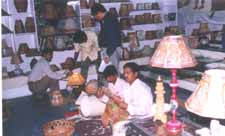The Lepakshi Heritage Collection

The Lepakshi Heritage Collection is an event that took place between 19-Mar-2001 and 24-Mar-2001 in Hyderabad.
-
Venue
-
Date/Time
-
Type
-
Price
-
Add New Field:
REVIEW FOR THE LEPAKSHI HERITAGE COLLECTION
Folklore has it that Lord Shiva and his wife Parvati once playfully entered two beautiful wooden figures that a carpenter had made and began to dance. Their fun over, they slipped out of the figures, which then fell lifeless. The carpenter who was overjoyed to see his creations come alive was heartbroken. He beseeched that they be given life again. Shiva relented and showed him how to do so, using strings. And thus was born an art form.
The mesmerizing play of dolls has been an ingrained cultural aspect of Indian tradition. In fact, it is believed that its origin dates back to BC. It could be that the wandering entertainers desired to animate picture-stories, and therefore we have a range of forms in India that categorizes a rich tradition of puppetry.
A grand myth and more also supports the 'Bommalaata' in Andhra Pradesh. Bommalaata, or leather puppetry, is a spectacular ancient community art that was basically patronized by the kings and the aristocracy of Andhra Pradesh. The popularity of this art until recent times was such that entire villages would flock around the puppeteers to seek visual pleasure and entertainment.
The apparatus for the stage is a simple bamboo box contraption that animates these 2-D puppets. To create shadows, lights hang directly above the puppeteers, behind a screen. These lights used to be coconut shells filled with oil and lit with cotton wicks, but were later substituted by either gas lamps or electric bulbs.
Accompanied by mythological narration and music, the 'bommalu', or the puppets, brightly hand painted in and around the holes pierced into the processed parchment leather so that each character is distinctly recognizable, are brilliant cutouts that fill the eye with a tinge of exoticness. These puppets are currently crafted in three villages - Narasaraopet of Guntur district and Dharmavaram and Nimmalakunta of Anantapur district.
Altering socioeconomic patterns spelled disaster to the practicing communities. What should concern us most is the evaporating essence of this tradition. Although the Government of Andhra Pradesh has set up the A P Handicrafts Development Corporation Limited and there are a few other agencies working on the revival of the craft, the good work has definitely altered and the origin of 'bommalaata' has been displaced, rendering it to a mere design, an artifact that may or may not pass on its history to a new audience and generation.
The function, as such, of this craft is definitely defunct. And not only in the villages it used to thrive in, but also in the urban interiors where, once it reaches them, the puppets are altered into forms like lampshades and other design appliances.
Narrating episodes from the epics for ages, the puppeteers have not only provided a local flavor to Indian mythology, but have also evolved a specialized craft associated with bommalaata. The ongoing exhibition-cum-demonstration of leather puppet making at the Lepakshi Emporium in Gunfoundry is attracting denizens and tourists alike to interact with the craftsmen especially brought in from the three villages.
Panduranga Rao from Narsaraopet had undergone training since six years and is today a deft artisan representing the 30-odd families engaged in this tradition and leading it from entertainment to design application. S Chidambarao and D Venkatramana of Dharmavaram do not differ. They too have roots in families that are traditionally absorbed in this craft.
"Although we have adjusted well with the cultural and economic changes, our elders find it difficult to accept this shift in the concept of the craft," says Ramana. "The only semblances of bommalaata left are those that we perform when we are invited to events in public places like Shilparamam and the Delhi Trade Fair," supplements Chidamba Rao.
AA
USER REVIEWS FOR THE LEPAKSHI HERITAGE COLLECTION
Be the first to comment on The Lepakshi Heritage Collection! Just use the simple form below.
LEAVE A COMMENT
fullhyd.com has 700,000+ monthly visits. Tell Hyderabad what you feel about The Lepakshi Heritage Collection!
MORE EVENTS IN THIS PERIOD
ALL EVENT CATEGORIES
SEARCH EVENTS
Dissatisfied with the results? Report a problem or error, or add a listing.
ADVERTISEMENT
SHOUTBOX!
{{ todo.summary }}... expand »
{{ todo.text }}
« collapse
First | Prev |
1 2 3
{{current_page-1}} {{current_page}} {{current_page+1}}
{{last_page-2}} {{last_page-1}} {{last_page}}
| Next | Last
{{todos[0].name}}
{{todos[0].text}}
ADVERTISEMENT
This page was tagged for
lepakshi collection hyderabad
Super Agencies events
March 2001 events
hyderabad arts
hyderabad exhibitions